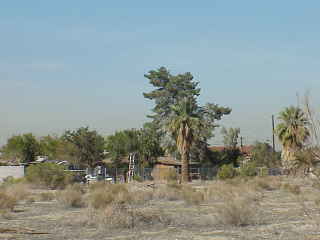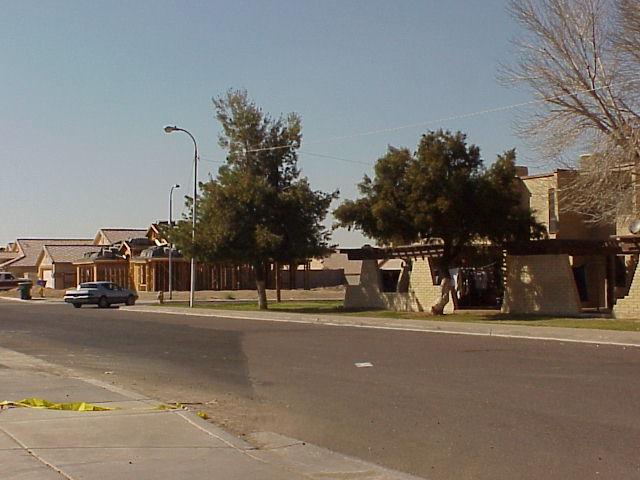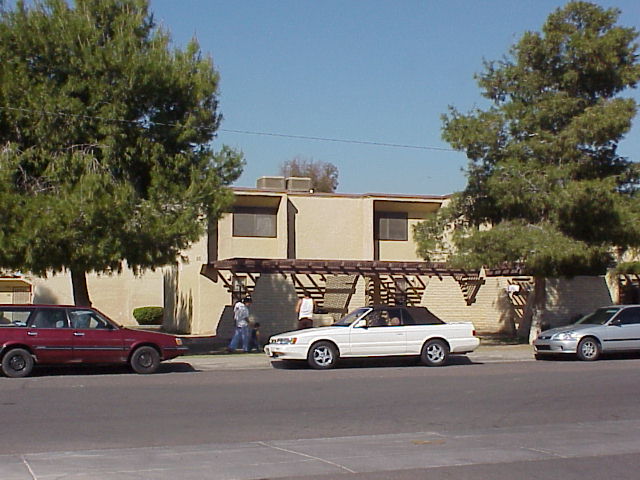
Old and New Cribs in South Phoenix

The housing in South Mountain Village, once known as
just South Phoenix, has changed drastically over the years. The past
developments here had not been enforced by any major zoning, so most of the
houses are
thrown
in between retail and government land. The last of the older houses
are various sizes too. Ranging from quarter acres to many acres, some people
here have a lot of land, giving the area a rural feeling.
As I went into developments east of Central and south of Broadway, I noticed that the older homes have a huge architectural impact on the environment. There is not any respect for the desert when looking at the landscaping of these older homes. The houses have lawns and trees. There are even palm trees and heavy landscaping. It seems people built this up as if they forgot that they were living in the desert. The architecture of these houses is varied too. Some houses are Tudor style, like you would find in the Midwest and on the East Coast. These homes are two stories and again donít fit in with this area. Most of them were built in the 60ís and 70ís it seems. Some were built later in the 80ís. The colors of these homes are varied. There are houses that are blue, green, brown, black; anything goes with the older homes. These houses are not in master planned communities at all, and the area around is rather deteriorated, for instance torn down fences with a shopping cart sitting outside of the property.
 The houses we see springing up today are master planned community housing. This
means lack of variation in architectural design and cookie cutter variety.
These houses are four years old at the most and mainly occupied by low-middle
income Caucasians. Most of these developments off of Baseline donít have too
many houses in each subdivision. The security is provided by ADT, and this is
showcased with signage by the driveway. There is recycling going on, with a
huge blue bin by the curb that is Phoenix recycling. There is practically no
landscaping at all, this is Xeriscape (zero-scaping), but a few small plants are
on the gravel. If you need to get your mail, community mailboxes are at the
center of the subdivision. There are mini cul-de-sacs, but nothing major or
pushed back. These houses are mainly 4-bed and
The houses we see springing up today are master planned community housing. This
means lack of variation in architectural design and cookie cutter variety.
These houses are four years old at the most and mainly occupied by low-middle
income Caucasians. Most of these developments off of Baseline donít have too
many houses in each subdivision. The security is provided by ADT, and this is
showcased with signage by the driveway. There is recycling going on, with a
huge blue bin by the curb that is Phoenix recycling. There is practically no
landscaping at all, this is Xeriscape (zero-scaping), but a few small plants are
on the gravel. If you need to get your mail, community mailboxes are at the
center of the subdivision. There are mini cul-de-sacs, but nothing major or
pushed back. These houses are mainly 4-bed and 2.5-bath. Three styles provide houses with no major distinctions form each
other, making for a boring place to live. The colors of these homes are light
green, light grey, and amber. There are not any sidewalks here, and the houses
sit on very tiny lots with no room between each other, maybe 50 feet at most.
They have 3 car garages and are mainly 2400 square feet. The homes in this
subdivision that were still available were selling for $232,500. This seems
steep to me. Houses that I am used to, in the Midwest and East coast, tend to be over 4000 square feet and have basements and
are not single level like these homes.
2.5-bath. Three styles provide houses with no major distinctions form each
other, making for a boring place to live. The colors of these homes are light
green, light grey, and amber. There are not any sidewalks here, and the houses
sit on very tiny lots with no room between each other, maybe 50 feet at most.
They have 3 car garages and are mainly 2400 square feet. The homes in this
subdivision that were still available were selling for $232,500. This seems
steep to me. Houses that I am used to, in the Midwest and East coast, tend to be over 4000 square feet and have basements and
are not single level like these homes.
The difference
in the housing between older South Phoenix and the newer South Mountain Village is
huge.
These homes look very different and the communities that they are set up in are
not similar. The housing that is being created here was supposed to make this
area look nicer I thought, but instead it provides expensive and ugly homes that
destroy the homes, rural atmosphere of this area. I see that Phoenix would like
to clean up South Mountain Village, but this is
not the way to go. There needs to be less expensive housing that is more fun
and inviting to the people that already live there.
First Time Buyers
The
City of Phoenix has set up a first-time homebuyers program for families that do
not make enough money to buy a home on their own. Mortgages here are offered at
4% interest to buyers. There must be a
$500
down payment by homebuyers and they also must pay the closing costs. The total
price of the home with all extra costs canít exceed the maximum amount that is
loaned to the homebuyer.
This program is restricted to those that are eligible. The buyer cannot have owned a home within the last three years. Annual income canít exceed 60% of median income for the Phoenix area, according to family size. The property that is bought must be occupied by the buyer as a principal resident.
This program shows how it appeals to low income families. As family size varies, so does the maximum income level for a qualifying family. For example: a family size of one could make at most $24,320 a year, a family size of eight could make at most $45,860 a year.
There are also various program guidelines for participants to buying a home. The value of a home must be established by an appraisal by a qualified appraiser. A minimum of $5,000 in rehabilitation must be needed for the home that is going to be bought. All of this rehabilitation must be completed before the house is occupied. The City of Phoenix building codes enforces the rules of the house that is bought. Condominiums and town-homes are sold on a case by case basis.